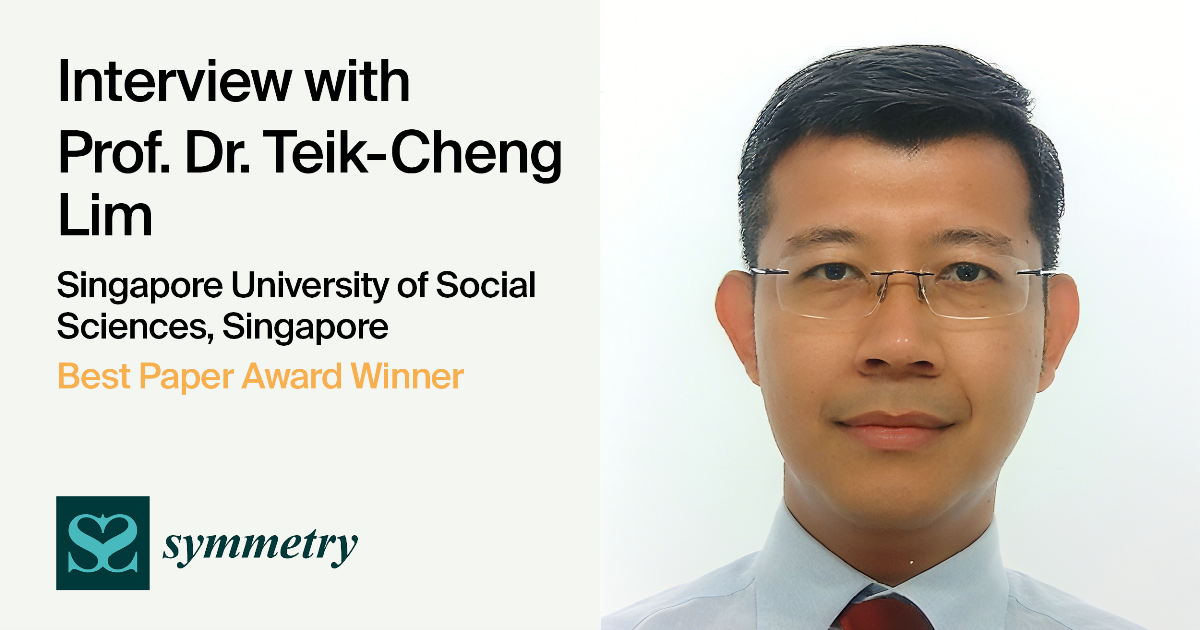Need Help?
12 August 2025
Interview with Prof. Dr. Teik-Cheng Lim—Winner of the Symmetry Best Paper Award

We are pleased to announce that Prof. Dr. Teik-Cheng Lim’s paper “Metamaterial with Tunable Positive and Negative Hygrothermal Expansion Inspired by a Four-Fold Symmetrical Islamic Motif” has been chosen as one of the exceptional articles published in Symmetry (ISSN: 2073-8994) during 2023 and won the Symmetry 2023 Best Paper Award. As a winner, Prof. Dr. Lim will receive CHF 400, a certificate, and a free voucher for article processing fees valid for one year.
The following is a short interview with the winner, Prof. Dr. Teik-Cheng Lim:
1. Congratulations on winning the Symmetry 2023 Best Paper Award! Could you please briefly introduce yourself?
I studied mechanical engineering at the National University of Singapore for both my undergraduate and PhD. For my PhD, I worked on the sheet forming of knitted fabric composites, a multidisciplinary topic bridging mechanics, manufacturing, and materials. For my postdoctoral work, I conducted some research on the electrospinning of nanofibers. I also explored other fields, including mathematical chemistry and molecular physics. Eventually, I focused my research on auxetic materials—materials that exhibit a negative Poisson’s ratio. As a relatively new and emerging field, developing about 20 years ago, studying auxetic materials allowed me to stay closer to the cutting edge of scientific research. I also worked on closely related topics, such as materials with negative thermal expansion, negative compressibility, and negative moisture expansion. These materials behave oppositely to conventional ones and often require engineered microstructures to achieve such properties. My publications primarily centered on mechanical metamaterials, where I investigated these unconventional behaviors through the design of artificial microstructures.
2. Could you give a brief overview of the main content of your award-winning paper?
In my paper, I present a type of metamaterial composed of repeating microstructures that function like a simple machine. My design features overlapping Y-shaped rigid units connected by bimaterial spiral strips. When exposed to such environmental changes, these strips encounter a change in their curvature due to their contrasting expansion coefficients, causing the pairs of Y-shaped units to rotate opposite to each other. This collective rotation changes the size of the unit cell, allowing the material to exhibit either a highly positive or highly negative effective expansion coefficient. The direction and magnitude of this response can be tuned by reversing the orientation of the bimaterial layers. At certain configurations, the metamaterial exhibits Islamic geometrical patterns.
3. Please introduce your current research focus and the main research areas of your team?
Over the past three years, my research has focused on designing materials with negative Poisson’s ratios using assemblies of rotating rigid units. In my latest work, these rotating units are designed to split into smaller sub-units. When the metamaterials are compressed, the units rotate in one way, but when they are stretched, they separate into smaller sub-units and rotate differently. This causes the metamaterials to respond in different deformation mechanisms depending on whether they are being compressed or pulled, leading to the discontinuity of Poisson’s ratio values at the original state.
4. Could you describe some challenges and breakthroughs in your research field?
A major challenge with these metamaterials is that the knowledge in this area is insufficient for them to be commercialized. I believe significant breakthroughs will occur in the coming years, which will enthuse the industry to adopt mechanical metamaterials on a wider scale.
5. What factors attracted you to submitting your paper to Symmetry? How was your submission experience?
I typically submit my work to journals specializing in solid-state or condensed matter physics, solid mechanics, and materials science. However, when my research involves microstructures with interesting symmetrical patterns, I choose to submit my paper to Symmetry. As for my submission experience, I’m highly satisfied. The process was straightforward, and any questions I had were promptly and efficiently addressed by the editorial office.
6. In your opinion, which research topics will attract widespread attention in the academic community in the coming years?
In my opinion, the application of Artificial Intelligence in natural and technological sciences will garner attention in the scientific community in the years to come.
7. What advice would you give to young researchers who aspire to produce high-impact research results?
I would advise young researchers to be bold and explore research areas of their interest and natural ability rather than following the latest trend.
8. As the recipient of this award, could you share your feelings and whom you would like to thank?
I didn’t expect to receive this award, especially since the paper was published some time ago, and I’ve since moved on to other research areas. When I saw the notification email, I was surprised and felt elated. I immediately shared the news with my wife to celebrate, and I feel deeply honored and humbled to be selected. This recognition is a great joy and pleasure, and I’ve struggled to find the right words to express my feelings. I’d like to thank my family for their constant support—especially my parents and my wife. I’m also deeply grateful to all my teachers and to my colleagues, with whom I frequently discuss my work. Lastly, I want to express my sincere thanks to the award committee and the journal Symmetry for this incredible honor.
9. Symmetry is an open access journal. How do you think open access impacts readers and authors?
I believe open access is highly beneficial for readers, as it removes subscription paywalls and allows free access to research. One significant advantage of open access is the potential for a paper to receive a higher number of citations.
More information about journal awards can be found at: https://www.mdpi.com/journal/symmetry/awards.

